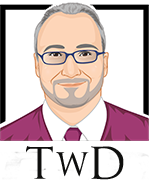
Debts
31 October 2021
The eighth wonder of the world
31 October 2021Before continuing this journey, I would like to complete this first part by discussing a book written by Robert Kiyosaki. There are few people who have not read his "Rich Dad, Poor Dad" (click on the title to buy it on Amazon) in which the author recounts his childhood in which he explains how he lived with two fathers.
His natural father was a man who has completed his studies, specialized and then became a professor, yet always had financial problems (poor father). His father's best friend, on the other hand, despite not having completed any studies, became one of the richest men in Hawaii (rich father).
The most important thing is not money, but education. Those who are pliant and open-minded get rich despite changes. Intelligence solves problems and produces money. In the long run,
"it doesn't matter how much money you make, but how much you are able to keep, and for how long you keep it for."
The number one rule, and the only rule, is to distinguish between assets and liabilities.
In the world, there are three types of categories of people from an economic point of view: the poor, the middle class, the rich. The interesting thing is that this difference is not (only) due to how much money each individual earns but where this money flows, i.e., cashflow. There can be lawyers who earn ten times as much as a clerk and still have problems.
Cashflow is very simple to build, at the bottom you put two boxes, which are filled with assets (left) and liabilities (right). At the top, we put two other boxes, one for income, one for expenses. As shown below.
Before we go any further, let's take a closer look at the individual entries:
- Cashflow, the direction in which money flows.
- Income, money earned. In most cases, this comes from a job.
- Expenses, the money we spend to support ourselves, our family and everything we own.
- Assets, anything that contributes to our income (bonds, stocks, real estate, etc.).
- Liabilities, whatever increases expenses instead of generating income.
In the diagram, the flow of money is represented with arrows. So, the top part is a profit and loss account, the bottom part is a balance sheet.
- The cashflow of a poor person is as follows: money comes into the Income box from work. From there it goes down to Expenses: taxes, food, rent, clothing, transportation, and so on.
- The cashflow of a middle-class person is this: money comes into the Income box from work. From there it flows down to the expenses seen above. But that's not the end of it, in fact, there are also liabilities: the mortgage for the house you own, consumer loans, credit cards.
- The cashflow of a rich person instead has arrows that go in an upward direction: he has assets (bonds, stocks, real estate, intellectual property) that produce income such as interest, dividends, rental income, royalties.
This is why having more money is not enough, because the cashflow model you have in your head will be reinforced. For example, if you have more money and start living in a bigger house your expenses will also increase. Therefore, a change in mindset is necessary.
The "secret" to getting rich is to be able to distinguish whether what we are buying is an asset or a liability. It may happen that an object, such as a house, can be an asset or a liability depending on the use we make of it. It is an asset if it is rented and, after deducting expenses and taxes, generates an income. It is a liability when it is, for instance, the house in which we live and which does not generate income but rather only expenses.
So, in conclusion, the message Kiyosaki sends with his book is not to live a moderate life, free of vices. What matters is timing. Every vice becomes accessible if it comes from earning your assets, whereas it isn’t if it comes from your work.
What matters is changing your mindset. You have to realise that it is money that has to work for you, not you for your money.
"Focus on spending your money on assets, not liabilities, until the money you earn from your assets is even higher than your salary."
And when those assets generate enough income to cover all your expenses, you will have become financially independent and have gained the most valuable asset: free time.
Those who are pliant and open-minded get rich despite changes. In the long run, it doesn’t matter how much money you make, but how much you are able to keep, and for how long you keep it for
I am a macroeconomic and financial analyst with over 30 years’ experience, including two years as a fund manager. I specialise in currencies and commodities, and I am the author of several successful books on trading, macroeconomics, and financial markets.







